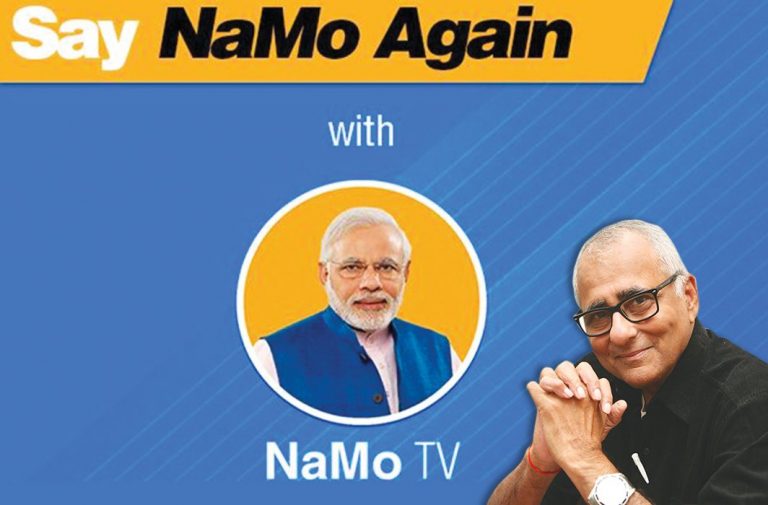
Above: As the NaMo TV controversy raged, the BJP admitted that it was a part of a party-financed media blitzkrieg
By Inderjit Badhwar
A constant criticism of elected governments in this country has been that once they come into power they use the State as their private milch cow. They use public resources for private and political benefit. They exercise ownership rights, throwing all accountability to the winds. And they escape mostly unpunished except for an occasional defeat at the polls.
The most recent and blatant example of this transgression has been the sudden appearance of a propaganda outlet on all cable and satellite TV platforms—NaMo TV. It had been blaring 24×7 wall-to-wall election and related speeches of the prime minister without any equal time provisions for opposition leaders.
It is a well established principle of broadcasting norms across the world’s democracies that the airwaves are a public resource. The airwaves belong to the public and cannot be privatised. If they are rationed between broadcasters competing for shares of the band-width and spectrum available, they can only be held in trusteeship and not in perpetual ownership.
In America, the Federal Communications Act of 1934, which established the Federal Communications Agency (FCC), recognised the need for strict regulation of the broadcast spectrum. Under the rules then framed, qualified broadcasters are granted renewable licences subject to withdrawal on public challenge in case the broadcaster enjoying this privilege abuses the terms and conditions of the licence or fails to perform in the public interest. One facet of the law is the equal time provision under which broadcasters must give space to opposing points of view. Even the president cannot hog air time to project a political viewpoint without the opposition being given a chance to respond.
That’s what democracy is all about: freedom from monopoly over the dissemination of views of information by any single entity. No wonder that opposition parties and some sections of the media kicked up a ruckus over NaMo TV. Who owned it? Who ran it? Did it have a licence to operate? How come it was being compulsorily carried on a prominent DTH platform like the prestigious Tata Sky?
Strangely, the channel was not listed among those permitted by the Information and Broadcasting Ministry (MIB). Under the Policy Guidelines for Uplinking of Television Channels in India, a channel can legally broadcast content only after it is given permission by MIB in accordance with Clause 9 of the guidelines. After ascertaining that the applicant has met the requisite criteria, MIB forwards the application to the Ministry of Home Affairs (MHA) for security clearance. After the MHA approval, the broadcaster must obtain further written permission to get authorisation from the Ministry of Communications and Information Technology.
When the hullaballoo over NaMo TV reached the Election Commission, it asked for an explanation from the MIB. The ministry responded that the channel was an advertising platform and did not require a licence from the ministry.
This was sheer bafflegab. It made no legal or administrative sense. According to Clause 3 of Rule 7 of the Cable Television Networks Rules, 1994, “No advertisement shall be permitted, the objects whereof are wholly or mainly of a religious or political nature; advertisements must not be directed towards any religious or political end.”
There was, in addition, a legal precedent to prohibit such malpractices. The Supreme Court in Secretary, Ministry of Information & Broadcasting vs M/s Gemini TV Pvt Ltd upheld that Rule 7(3) of the Cable Television Networks Rules, 1994, prohibits advertisements of a religious or political nature on television channels. This rule had been challenged before the Andhra Pradesh High Court in several writ petitions. The High Court passed an interim order on March 23, 2004, staying the operation of Rule 7(3). The MIB filed an SLP before the Supreme Court. The Court, in an interim order passed on April 13, 2004, directed that political parties, candidates or any other person or organisation intending to issue advertisements of a political nature on a TV channel or cable network, should submit an application to the Election Commission or an officer designated by the Commission along with copies of the proposed advertisements. The advertisement can be aired only after obtaining clearance from the Commission.
Clause VII(4) of the Model Code of Conduct also states that media advertisements issued at the cost of the public exchequer and the misuse of official mass media during the election period “for partisan coverage of political news and publicity regarding achievements with a view to furthering the prospects of the party in power shall be scrupulously avoided”.
As the NaMo TV controversy raged, saffron-faced BJP spokespersons had to admit that the channel was indeed a part of a party-financed media blitzkrieg. And the Election Commission, as it came under fire from all quarters for looking the other way, finally issued a directive on April 11: “It has been brought to the notice of the Commission that NaMo TV/Content TV is a platform service offered by DTH operators to the BJP on a paid basis…any political publicity material or contents being displayed on electronic media without the requisite certification from competent authority [media certification and monitoring committee in this case] should be removed immediately and any political content shall only be permitted strictly in accordance with the EC instructions in this regard.”

In other words, NaMo TV, sponsored by the BJP, cannot display election matter during the silence period prescribed in the electoral law in each of the remaining five phases of the ongoing Lok Sabha elections. But that seems to be akin to bolting the stable doors after the horses have fled.

